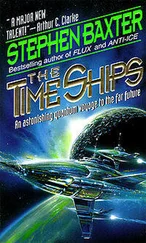The world we care most about is, of course, Pandora, fifth moon of Polyphemus.
The larger moons, like Pandora, probably formed from the same swirl of debris that formed Polyphemus itself; the smaller ones may be captured asteroids. There are limits on where big moons might be found in relation to the primary world. Sensible spherical moons need to be outside the primary’s “Roche limit,” within which tidal effects are so strong they pull the moon apart; inside the Roche limit you may get shapeless asteroid-like lumps of rock, but not round worlds. The precise distance depends on the mass and rotation of the primary, and on the composition of the moon, but as a rule of thumb the Roche limit is around two and a half times the primary’s radius, measured from the planet’s centre. Thus Saturn’s innermost spherical moon Mimas is three Saturn radiuses out. You can see from the onscreen size of Polyphemus in Pandora’s sky that Pandora is safely out beyond the Roche limit. Some close-in moons of gas giants are “tidally locked,” so that they keep one face permanently set towards the primary, as the moon does to the Earth. This isn’t the case with Pandora; during its twenty-six-hour day Polyphemus rises and sets.
In real life we’ve yet to detect any worlds of Alpha Centauri. But we have found an awful lot of worlds orbiting other stars.
One of the true scientific miracles of my lifetime has been the discovery of “exoplanets,” indeed in some cases whole other solar systems. When I was a boy not a single planet beyond the sun’s family was known. Some scientists maintained there were no other worlds—that the solar system was a freak, a matter of chance. Now, at the time of writing, we know of more than four hundred other worlds. We’re starting to learn a good deal about the distribution of planets and planetary systems, and are coming up with new theories of planetary formation. And we have new ideas of how planets may be habitable, suitable for life, even if in some cases they are dramatically different from our own Earth. It’s certainly timely for Avatar , a movie of travel to alien worlds, to appear just now. Suddenly we see a sky full of Polyphemuses—and, maybe, Pandoras.
The challenge of detecting worlds beyond our own is formidable, because planets are small and faint compared to their parent suns.
Suppose we were studying the solar system from a planet of the star Altair, in the constellation of the eagle (Aquila), about seventeen light years away. Even mighty Jupiter, the largest of the sun’s planets, would be lost in the sun’s glare. Jupiter’s apparent distance from the sun, from the point of view of an Altairean, would be only one-thousandth the width of a full moon seen from Earth, and its light, which is just reflected sunlight, only a billionth of the sun’s. It was once believed that you would need truly ginormous telescopes flying in space to resolve worlds like Jupiter out of the glare, let alone Earths, smaller, closer to the sun, even fainter. Not so.
While there had been tentative observations of planets orbiting pulsars (small supernova remnants) since the 1980s, in 1995 the scientific world was startled by the first observation of a planet orbiting a star called 51 Pegasi, a “main sequence” star (that is, a star in the middle of its normal lifetime, like our sun). The discovery was made not with giant telescopes but with improved instruments, careful observation and a dash of ingenuity.
An exoplanet is generally detected indirectly: not by observations of the planet itself, but by studying its effects on its parent star. The most productive technique to date has been the “radial velocity” method. As the planet orbits its star, the star itself is pulled out of position, just a little, and if some of this motion is towards or away from Earth you can detect it with a subtle shifting of the lines of the star’s light spectrum. This is the Doppler effect, the same phenomenon that causes the blue shift and red shift so familiar to hardened interstellar travellers like us. Alternatively there is the “transit” method. If the planet happens to pass across the face of its sun as seen from Earth—just like transits of Venus and Mercury, planets inside Earth’s orbit crossing the face of our sun—the dip in the star’s apparent brightness can be detected. Other techniques include using stars in the line of sight as gravitational “lenses.”
As you can imagine, these effects, though detectable, are small and subtle. The more massive the planet, and the closer it is to its parent star, the larger the effect and the more likely it is that the planet will be detected. Thus the first exoplanets found tended to be more massive than Jupiter, yet orbiting (to everybody’s surprise) very close to their parent stars. The very first discovered, at 51 Pegasi, was a “Jovian,” in the jargon, a gas-giant planet like Jupiter, orbiting its sun in just four days (our closest-in world Mercury takes eighty-eight days). Polyphemus is another example, a gas giant not much further from Alpha Centauri A than the Earth is from the sun.
There is an inevitable “observational bias” in our exoplanet detection. For a long time yet we are going to find more large, close-in worlds than small, further-out worlds, and the statistics of the planets we’ve found so far must reflect that. Nevertheless we have enough data now to start to classify the exoplanets and make some tentative predictions.
For example, eighty per cent of the exoplanets discovered have been in multiple-planet “solar systems” (which can be detected by observing the multiple tweaks the planets apply to their parent star’s motion). It’s thought that about a third of all sunlike stars will host planets the size of Neptune (around seventeen Earth masses), or “super-Earths,” worlds somewhere between Earth and Neptune in size. A super-Earth, by the way, would be a spectacular place, despite the higher gravity; the larger the world is the more geologically active it is likely to be, as the Earth is much more active than Mars or the moon. Expect fiery worlds, tremendous volcanoes.
The observational techniques are improving, but we’re still some way from being able to detect an “Earth,” orbiting at an Earthlike distance from a sunlike star. This would produce only a thousandth the deflection of the parent star of a close-in Jupiter (Jupiter has over three hundred times the mass of Earth).
So suddenly we’re seeing all these planets. But what about life?
It used to be thought that if it is to be liveable for creatures like us or the Na’vi, a world would have to be more or less Earth-sized, and would have to occur in the “habitable zone” of its parent’s star—orbiting at a distance from the star that would allow liquid water to occur on its surface, not too hot and not too cold, so at something like Earth’s distance from a star like the sun.
But in recent years we have discovered life surviving in quite extreme environments on Earth: in the deep sea where no sunlight ever penetrates, in conditions of cold and heat, even subject to radiation. Maybe life is more robust and flexible than we used to think.
And we have discovered new kinds of worlds, like Jupiter’s moon Europa, which under a crust of ice has a water ocean, kept liquid by tidal effects. Europa’s ocean seems a prime arena for life, even though it is far outside the traditional habitable zone.
In Avatar ’s fictional universe Pandora too is an example. Alpha Centauri A is about fifty per cent brighter than Sol, and its habitable zone is about twenty-two per cent wider than the radius of Earth’s orbit around the sun. Polyphemus with its moons follows an orbit about forty per cent wider than Earth’s, so is just outside the traditional habitable zone of Alpha A—but oxygen, a signature of life, was detected in Pandora’s air anyway. It turns out that Pandora is kept warm by complex effects include tidal heating, and by a greenhouse effect from an atmosphere thick with carbon dioxide, and by other aspects of its complex environment as a moon of a gas giant in a double star system. No doubt we will turn up many other exceptions to the habitable-zone rule in the future.
Читать дальше










